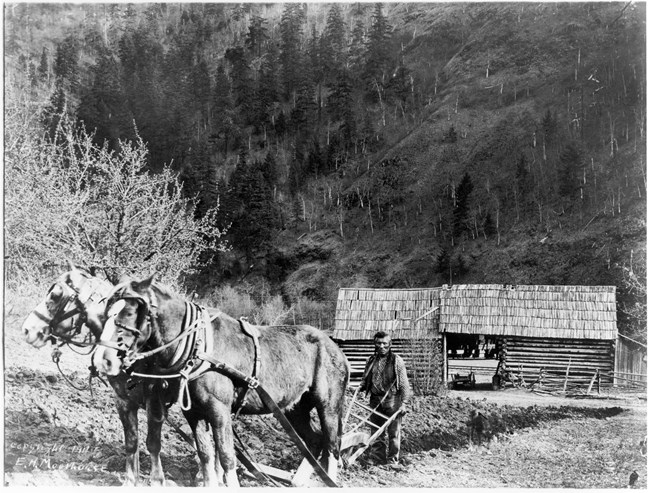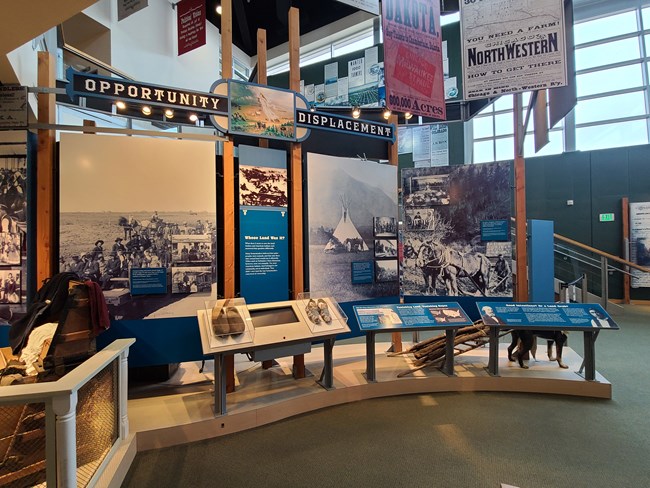 by a man across a field in front of a log structure" width="" />
by a man across a field in front of a log structure" width="" />Conflicts between Europeans and Native Americans were a problem long before the Homestead Act was passed in 1862. Treaties and laws like the Indian Appropriations Act of 1851 had pushed many Native Americans to reservations in the West. Homesteading added another layer to this already tense situation.
Land laws including the Homestead Act of 1862 impacted the lives of Native Americans across the United States. The struggle to maintain cultural identity and connections to the land still resonates today.
The Homestead Act of 1862 granted land claims in thirty states. These areas were the traditional or treaty lands of many Native American tribes.
Many homesteaders believed that all native peoples were nomads and that only those who owned land would use it efficiently. Few tribes were truly nomadic. Most nomadic tribes had certain locations they would travel to throughout the year. Other tribes had permanent villages and raised crops.
Native Americans believed land belonged to the community, not to individuals. They didn’t own land the ways homesteaders conceived of ownership. This conceptual difference raised conflicts between settlers and Native Americans.
The Homestead Act increased the number of people in the western United States. Most Native Americans watched the arrival of homesteaders with unease. As more settlers arrived, they found themselves pushed farther from their homelands or crowded onto reservations. Reactions were as complex and varied as the Native Americans themselves. Some looked for new opportunities. Many hoped to adapt. Other fought to hold onto their traditional ways of life. All recognized that changes would alter their lives forever.
With the increase in settlers, the land the Native Americans once knew changed:

Senator Henry Dawes of Massachusetts argued that Native Americans would prosper if they owned family farms. His 1887 Dawes Act carved Indian reservations into 160-acre allotments. This allowed the federal government to break up tribal lands further. Only those families who accepted an allotment of land could become US citizens.
The Dawes Act designated 160 acres of farmland or 320 acres of grazing land to the head of each Native American family. This was comparable to the Homestead Act, but there were important differences. The tribes controlled the land now being allotted to them. The lands were not owned by the federal government. Additionally, much of the land subject to the Dawes Act was unsuitable for farming. Often large tracts of the allotments were leased to non-Native Americian farmers and ranchers.
After the Native American families claimed their allotments, the remaining tribal lands were declared “surplus.” The remaining land was given to non-Native Americans. Land runs allowed the land to be opened to homesteaders on a first-arrival basis.
"Some citizens of the United States have title to land that was given to my fathers and my people by the government. If it was given to me, what right has the United States to take it from me without first asking my consent?" - Chitto Harjo, Creek Indian
Native American lands decreased significantly under the Dawes Act. Reservation lands went from 138 million acres in 1887 to 48 million acres in 1934! That is a loss of 65 percent, before the Dawes Act was repealed.
The interpretation of this story is not static. This is a complex story that varies in every state and with every tribe. New research continues to be conducted about the relationship between the Homestead Act and Native American land dispossession.
In Homesteading the Plains: Toward a New History (2017), the researchers found three major patterns across the western states: virtually no impact, minor impact, and direct impact.

At Homestead National Historical Park, visitors learn about many aspects of homesteading story. An exhibit titled "Opportunity and Displacement" discusses how land laws affected Native Americans. Consultations with Native Americans helped to create this exhibit at the Heritage Center. The park film "Land of Dreams" includes stories from indigenous peoples. The film highlights perspectives of Native Americans and descendants of homesteaders.
One of the distance learning programs provided by the park addresses the issue of land dispossession. The program "Follow the Buffalo" discusses traditional uses of buffalo parts by Plains tribes. The Homestead Act and changes in Native American life during the 19 th century are focal points in the program.